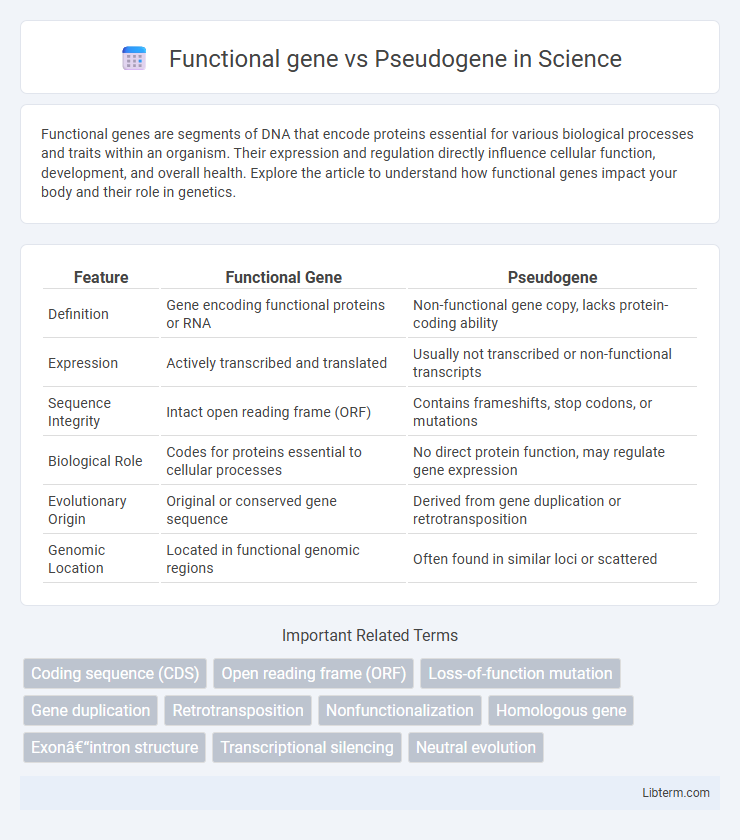Functional genes are segments of DNA that encode proteins essential for various biological processes and traits within an organism. Their expression and regulation directly influence cellular function, development, and overall health. Explore the article to understand how functional genes impact your body and their role in genetics.
Table of Comparison
| Feature | Functional Gene | Pseudogene |
|---|---|---|
| Definition | Gene encoding functional proteins or RNA | Non-functional gene copy, lacks protein-coding ability |
| Expression | Actively transcribed and translated | Usually not transcribed or non-functional transcripts |
| Sequence Integrity | Intact open reading frame (ORF) | Contains frameshifts, stop codons, or mutations |
| Biological Role | Codes for proteins essential to cellular processes | No direct protein function, may regulate gene expression |
| Evolutionary Origin | Original or conserved gene sequence | Derived from gene duplication or retrotransposition |
| Genomic Location | Located in functional genomic regions | Often found in similar loci or scattered |
Introduction to Genes: Functional vs Pseudogenes
Functional genes contain coding sequences that produce proteins essential for biological processes, driven by active transcription and translation. Pseudogenes resemble functional genes but harbor mutations such as insertions, deletions, or premature stop codons, rendering them nonfunctional and incapable of protein production. Their presence offers insights into gene evolution, genomic structure, and regulatory mechanisms without contributing directly to cellular functions.
Definition of Functional Genes
Functional genes are DNA sequences that encode proteins or functional RNA molecules essential for the biological processes and phenotypic traits of an organism. These genes are actively transcribed and translated to produce functional products that contribute to cellular metabolism, growth, and development. In contrast, pseudogenes resemble functional genes but have lost their ability to code for functional proteins due to mutations or deletions.
Definition of Pseudogenes
Pseudogenes are segments of DNA that resemble functional genes but have lost their ability to code for proteins due to mutations or deletions. Unlike functional genes, pseudogenes typically contain disruptions such as premature stop codons or frameshifts that prevent proper transcription or translation. These genomic elements serve as molecular fossils, providing insights into gene evolution and genomic organization.
Structural Differences Between Functional Genes and Pseudogenes
Functional genes contain intact open reading frames with regulatory elements such as promoters, enhancers, and splice sites that enable proper transcription and translation into functional proteins. Pseudogenes often exhibit structural defects including frameshift mutations, premature stop codons, and lack essential regulatory sequences, rendering them nonfunctional. Furthermore, pseudogenes are frequently characterized by the absence of introns or the presence of disrupted exon-intron structures, distinguishing them from their functional gene counterparts.
Evolutionary Origins of Functional Genes and Pseudogenes
Functional genes originate through processes such as gene duplication, horizontal gene transfer, and mutations that provide beneficial traits, allowing them to be preserved by natural selection. Pseudogenes arise from the accumulation of disabling mutations in once-functional genes, rendering them nonfunctional while retaining sequence similarity to their progenitor functional counterparts. The evolutionary divergence between functional genes and pseudogenes reflects a dynamic genomic landscape shaped by mutation, selection, and genetic drift.
Biological Roles and Impacts on Cellular Function
Functional genes encode proteins or RNA molecules essential for cellular processes such as metabolism, growth, and repair, directly influencing phenotype and organismal development. Pseudogenes, often arising from gene duplication or retrotransposition events, typically lack protein-coding potential but can regulate gene expression through mechanisms like antisense interference or competing endogenous RNA activity. Despite not producing functional proteins, pseudogenes impact cellular function by modulating gene networks and contributing to genomic complexity in evolution and disease states.
Methods for Identifying Functional Genes and Pseudogenes
Methods for identifying functional genes involve genomic sequencing combined with transcriptomic analysis to detect active gene expression and protein-coding potential, while pseudogenes are typically identified through sequence homology searches revealing frameshifts, premature stop codons, or lack of regulatory elements. Comparative genomics and evolutionary conservation analysis further distinguish functional genes from pseudogenes by highlighting conserved functional domains absent in pseudogenes. Advanced bioinformatics tools, such as gene prediction algorithms and RNA-seq data integration, enable high-confidence annotation of functional genes versus non-functional pseudogenes in complex genomes.
Functional Relevance of Pseudogenes: Beyond "Junk" DNA
Pseudogenes, once considered nonfunctional "junk" DNA, play significant roles in gene regulation, acting as decoys for microRNAs and influencing the expression of their functional gene counterparts. These sequences can modulate cellular processes by sequestering regulatory molecules, thereby impacting protein synthesis and contributing to genetic diversity and disease mechanisms. Recent research highlights their involvement in developmental pathways and cancer biology, underscoring the functional relevance of pseudogenes beyond traditional views.
Implications in Human Disease and Genetic Research
Functional genes encode proteins essential for normal cellular processes, with mutations often directly linked to human diseases such as cystic fibrosis and sickle cell anemia. Pseudogenes, once considered non-functional, can regulate gene expression and impact disease progression by acting as microRNA sponges or modulating chromatin structure. Understanding the roles of both functional genes and pseudogenes enhances genetic research, enabling novel diagnostic markers and therapeutic targets in complex disorders like cancer and neurodegenerative diseases.
Future Perspectives in Functional Gene and Pseudogene Studies
Future perspectives in functional gene and pseudogene studies emphasize advancements in single-cell sequencing and CRISPR-based gene editing to unravel complex regulatory mechanisms and gene expression dynamics. Emerging computational models integrating multi-omics data aim to distinguish pseudogene functions from nonfunctional sequences, enhancing annotation accuracy in genomic databases. These innovations hold potential for novel therapeutic targets and biomarker discovery, particularly in cancer and genetic disorder research.
Functional gene Infographic

 libterm.com
libterm.com